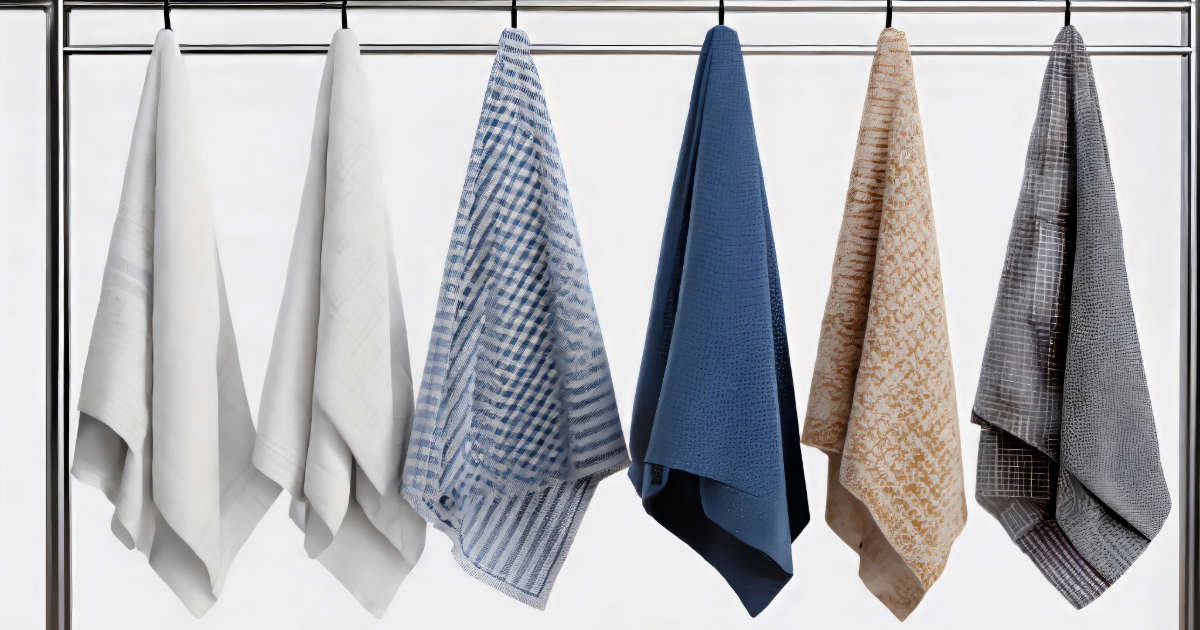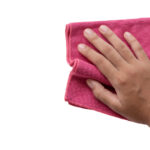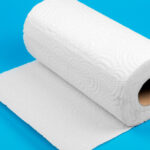Kitchen towels are an essential tool that every home cook needs.

From drying dishes to cleaning spills, kitchen towels serve a wide variety of purposes in the kitchen.
But with so many different types of kitchen towels available, it can be confusing to know which ones to choose.
What Are Kitchen Towels?
Kitchen towels refer to any towel designed for use in the kitchen. They are more durable and absorbent than regular bath or hand towels so they can withstand messes and frequent use.
The main purposes of kitchen towels include:
Having an assortment of kitchen towels on hand makes cooking and cleaning much easier. Kitchen towels are available in different materials, sizes, and absorbencies to suit the wide range of kitchen tasks.
Types of Kitchen Towels
There are several common types of kitchen towels that all serve different purposes. Here are the main options:
Dish Towels
Dish towels, sometimes called tea towels, are the classic multipurpose kitchen towel for drying dishes. They are made from a flat-woven cotton or linen material. The smooth, lint-free surface makes them ideal for drying glassware and dishes without leaving streaks or fibers behind.
Dish towels are lightweight and quick to dry. They absorb water well but can become saturated when drying a large load of dishes. Their key benefit is drying dishes streak-free.
Flour Sack Towels
Flour sack towels are made from tightly-woven cotton, originally using the fabric from cotton flour sacks. The thin but sturdy material works great for straining foods like yogurt or cheese.
Flour sack towels are very inexpensive, absorbent, and versatile. Like dish towels, they dry dishes without lint. Their lightweight texture also makes them a good choice for covering rising dough.
Terry Cloth Towels
Terry cloth towels have a looped pile construction which makes them very plush and absorbent. They work well for drying hands and are extra durable. However, the loops tend to leave lint behind so terry cloth is not ideal for drying dishes or glassware.
Terry cloth towels are best used solely for drying hands and wiping counters. They come in a wide range of colors to brighten your kitchen.
Waffle Weave Towels
Waffle weave towels have a honeycomb texture created by woven fibers. The waffled pattern makes them highly flexible and absorbent. They dry dishes well without leaving lint behind.
Waffle weave towels provide great maneuverability around dishes while absorbing lots of water. The textured surface also helps scrub surfaces when cleaning. They come in many colors and patterns.
Microfiber Towels
Microfiber towels are made from extremely fine synthetic fibers. Their microscopic fibers produce a very soft towel that is ultra-absorbent and lint-free.
Microfiber towels are excellent for cleaning and polishing. Their key benefit is picking up dust and dirt without the need for chemical cleaners. They also dry streak-free.
What Are Kitchen Towels Made From?
Kitchen towels are primarily made using cotton, linen, microfiber, and blends. Here’s an overview of each fabric:
For most kitchen tasks, 100% cotton towels provide the best experience at the lowest cost. Linen and microfiber work well but come at a higher price point. Terry cloth cotton is ideal for hands.
When to Use Different Kitchen Towels
It’s helpful to have multiple types of kitchen towels and use them for their intended purposes:
Don’t use terry cloth to dry dishes since it leaves lint. Only use dish towels or lint-free flour sack and microfiber towels on dishes and glassware.
Rotate kitchen towels frequently – don’t dry dishes with a wet towel or wipe counters with a messy towel. Keep hand towels separate from dish towels to prevent bacterial spread.
Caring for Kitchen Towels
To keep kitchen towels fresh, clean, and durable, follow these care tips:
With proper care, most 100% cotton towels will remain in good shape for several years. Linen may wear out faster with repeated machine washing.
Choosing Kitchen Towels
When shopping for kitchen towels, look for the following features:
For maximum versatility, have a variety on hand:
Quality 100% cotton towels provide the best performance for daily kitchen tasks. With the right assortment of absorbent, lint-free towels, you’ll be equipped to handle anything in the kitchen!
FAQs
What’s the difference between a tea towel and dish towel?
Tea towel is a British term for any towel used in the kitchen, including dish towels. In America, tea towel often refers to a decorative, thin cotton towel while dish towel describes a basic cotton towel for drying dishes and glassware.
Should you use bleach on kitchen towels?
Bleach can help sanitize kitchen towels and remove stains but may damage fabrics over time. Use oxygen bleach instead of chlorine bleach when possible. Always check label instructions.
How often should you replace kitchen towels?
It’s best to replace kitchen towels every 6 months to 1 year for hygiene. Stains, thinning fabric, holes, and faded colors also indicate it’s time to get new towels. Higher quality cotton towels may last several years.
What is the most absorbent kitchen towel material?
For maximum absorbency, cotton terry cloth is best, followed by cotton waffle weave and linen. However, terry cloth leaves lint behind. For a lint-free yet absorbent towel, choose cotton flour sack or certain cotton dish towels.
Should you use different kitchen towels for hands versus dishes?
Yes, it’s best practice to use separate towels – one for drying hands and another for drying dishes. This helps prevent transfer of germs from your hands onto clean dishes. An easy method is to use terry cloth for hands only and a smooth, lint-free cotton or linen towel for dishes.
Conclusion
Kitchen towels are available in a variety of fabrics, textures, and sizes to suit any kitchen task imaginable.
Understanding the differences between common kitchen towels like terry cloth, flour sack, waffle weave, and microfiber allows you to choose the right towel for the job.
Cotton is best in terms of value, absorbency, and versatility. But linen and microfiber each have their advantages as well.
Proper use and laundry care help kitchen towels maintain their shape and performance for years of reliable service.








